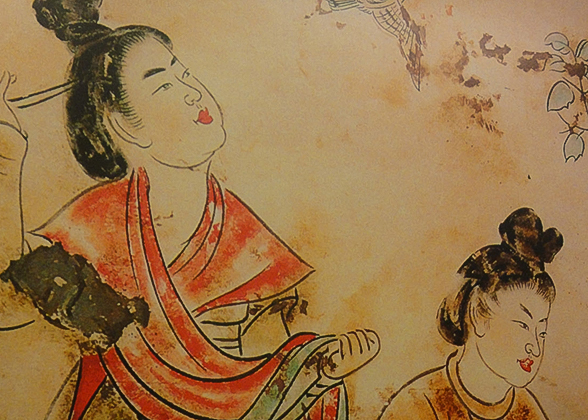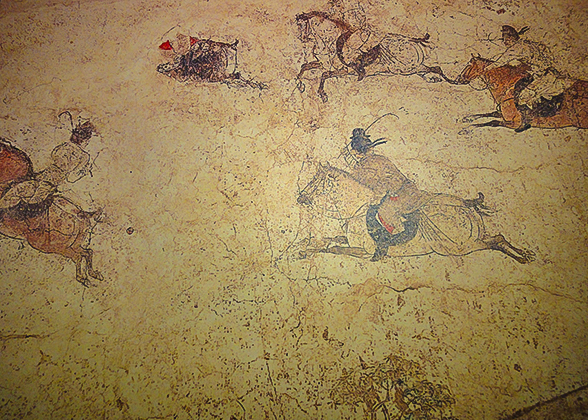The hall, being called the Uffizi Gallery of China, is the first exhibition hall in the Shaanxi History Museum dedicated to showing murals of the
Tang Dynasty. The museum houses almost 600 murals in 20 tombs such as the tombs of Lishou and Princess Yongtai. It has 97 pieces on show to the public and the contents cover various aspects of daily life in royal families, illustrating their love for life and nature as well as the humanism of the Tang Dynasty. In the museum, a video named “Memory of Tang Dynasty” is shown on a loop to guide the audience and help them understand the frescos clearly. Among these masterpieces are the famous Mural of Playing Polo; Mural of Hunting and the Maid Painting.
 Pictures of Murals of Tang Dynasty
Pictures of Murals of Tang Dynasty Murals from Tomb of Crown Prince Zhanghuai
In this hall you will find three famous masterpieces from the tomb of Crown Prince Zhanghuai . “The Mural of Guests and Ambassadors”, illustrates vividly the ambassadors’ different characteristics from different countries. Three dignified and graceful officials are standing on one side, while three nervous ambassadors are standing on the other. This work of art demonstrates the constant communication between China and various western countries. "The Mural of Playing Polo”, also found in this tomb is 9 meter’s (29 feet) long and divided into five sections. It depicts more than 20 royal family members playing the polo. Five players in the foreground of the work are attractive. Some are preparing to hit the ball while others are pictured running quickly. The backdrop consists of five trees, which combine the quietness of the surroundings and the noise of the activities. Even though the picture is big, all the images are well-proportioned.
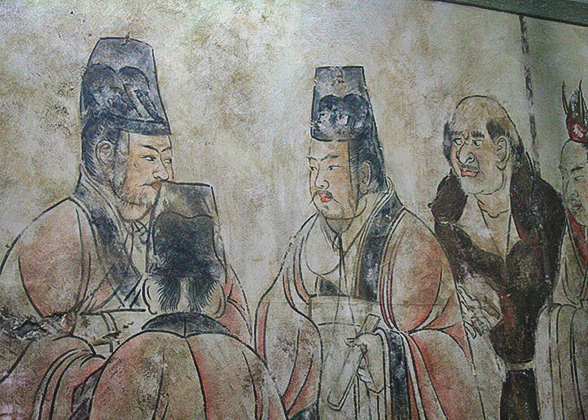 | | The Mural of Guests and Ambassadors | | 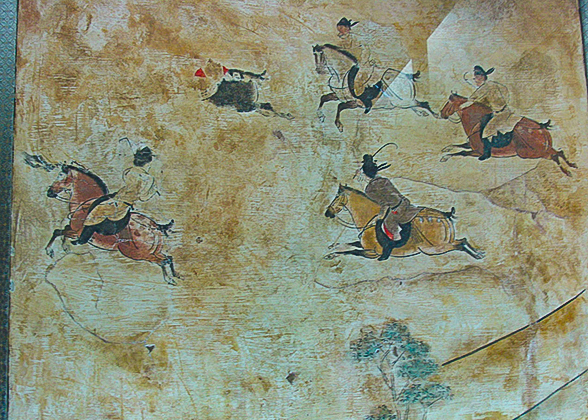 | | The Mural of Playing Polo | |
The third fresco housed in this tomb is named “The Noble Lady” and shows the earliest ice-cream in the world. While many people may think that ice-cream is the modern product from the west, it actually existed early in the Tang Dynasty over 1000 years ago and it was called Su Shan then. In “The Noble Lady”, two out of the six ladies are holding Su Shan, experts first thought they were holding potted landscapes however, through the comparison between the exquisite plates of food and the plates of ‘potted landscapes’, the experts from the History Museum of Shaanxi Province interpreted it as “Su Shan” with flowers on the top.
According to some documents, Su Shan usually had ice at the bottom and cream and butter on the top and very often, it was decorated with colorful flowers and tree leaves.
“Su” was originally a kind of dairy product – similar to cream and butter – introduced to the central part of China by the nomadic people from the north. It was not only tasty, but also rich in nutrition. In addition to white Su Shan, there were other varieties such as red Su Shan and green Su Shan known as “Royal Red” and “Eyebrow Dark” respectively.
Su Shan was often made by ladies who first, heated the Su until it melted. Then they trickled it onto a plate in the shape of a mountain. Finally, freeze it in an ice-house.
According to documents, Su Shan was very popular in the Tang,
Song (960-1279), and
Yuan Dynasties (1271-1368) in China.
Murals from Tomb of Crown Prince Yide
The theme of “The Mural of Pavilions” in the
tomb of Crown Prince Yide is the pavilions of royal family members. Inside the pavilion, the Honor Guard of the emperor is waiting there. The fresco is special for displaying the structure of the pavilions, which were only for emperors’ buildings and tombs at that time. “The Mural of Honor Guard” consists of 200 officials and carriages in a parade. The splendid decorations show clearly the status of the person in the tomb.
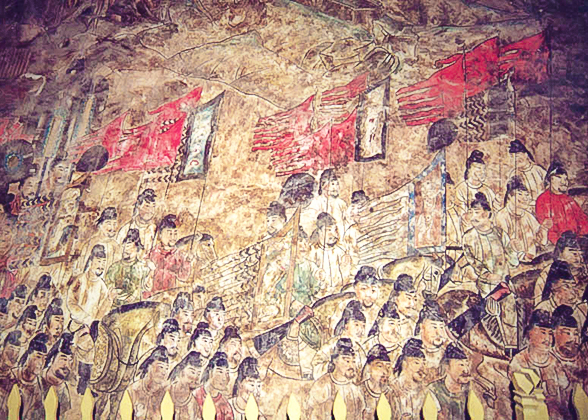 | | The Mural of Honors Guard | | 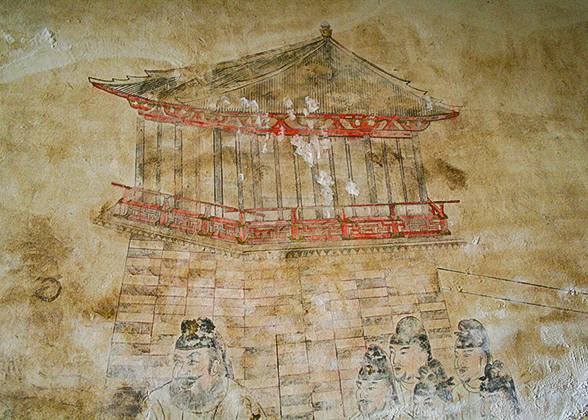 | | The Mural of Pavilions | |
Murals from Tomb of Princess Yongtai
Frescos in this hall are all collected from the tombs of royal family members who lived luxurious lives. Their relatives hoped that they would have the same treatment after they died; all these frescos reflect the good wishes of family members which is still a Chinese tradition. When you see these pictures, you can enjoy not only the exquisite drawing skills of the ancient time, but also the splendid Chinese culture.
Besides these paintings, 18 related articles are shown as supplements on the display, which help you acknowledge the related information about murals from the Tang Dynasty.
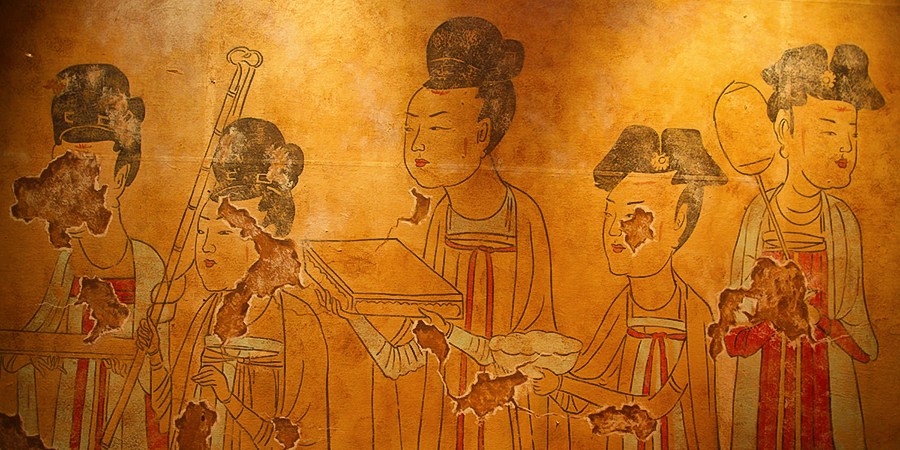 |
| The Mural of Maids in Imperial Palace |

Ticket and Special Notice
Although Shaanxi History Museum is open to the public for free, it costs 300 RMB per person to enter the exhibition hall; the entrance fee is a way of controlling the number of visitors in order to protect the precious artworks. All these murals are kept under special conditions using high-tech equipment. Also, photography is forbidden.
- Last updated on Jul. 05, 2024 by Gabby Li -
 Pictures of Murals of Tang Dynasty
Pictures of Murals of Tang Dynasty Ticket and Special Notice
Ticket and Special Notice


